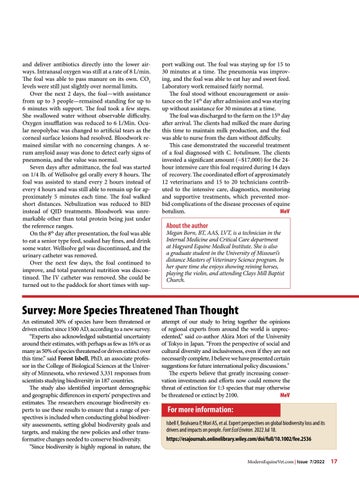and deliver antibiotics directly into the lower airways. Intranasal oxygen was still at a rate of 8 L/min. The foal was able to pass manure on its own. CO2 levels were still just slightly over normal limits. Over the next 2 days, the foal—with assistance from up to 3 people—remained standing for up to 6 minutes with support. The foal took a few steps. She swallowed water without observable difficulty. Oxygen insufflation was reduced to 6 L/Min. Ocular neopolybac was changed to artificial tears as the corneal surface lesions had resolved. Bloodwork remained similar with no concerning changes. A serum amyloid assay was done to detect early signs of pneumonia, and the value was normal. Seven days after admittance, the foal was started on 1/4 lb. of Wellsolve gel orally every 8 hours. The foal was assisted to stand every 2 hours instead of every 4 hours and was still able to remain up for approximately 5 minutes each time. The foal walked short distances. Nebulization was reduced to BID instead of QID treatments. Bloodwork was unremarkable other than total protein being just under the reference ranges. On the 8th day after presentation, the foal was able to eat a senior type feed, soaked hay fines, and drink some water. Wellsolve gel was discontinued, and the urinary catheter was removed. Over the next few days, the foal continued to improve, and total parenteral nutrition was discontinued. The IV catheter was removed. She could be turned out to the paddock for short times with sup-
port walking out. The foal was staying up for 15 to 30 minutes at a time. The pneumonia was improving, and the foal was able to eat hay and sweet feed. Laboratory work remained fairly normal. The foal stood without encouragement or assistance on the 14th day after admission and was staying up without assistance for 30 minutes at a time. The foal was discharged to the farm on the 15th day after arrival. The clients had milked the mare during this time to maintain milk production, and the foal was able to nurse from the dam without difficulty. This case demonstrated the successful treatment of a foal diagnosed with C. botulinum. The clients invested a significant amount (~$17,000) for the 24hour intensive care this foal required during 14 days of recovery. The coordinated effort of approximately 12 veterinarians and 15 to 20 technicians contributed to the intensive care, diagnostics, monitoring and supportive treatments, which prevented morbid complications of the disease processes of equine botulism. MeV
About the author
Megan Born, BT, AAS, LVT, is a technician in the Internal Medicine and Critical Care department at Hagyard Equine Medical Institute. She is also a graduate student in the University of Missouri’s distance Masters of Veterinary Science program. In her spare time she enjoys showing reining horses, playing the violin, and attending Clays Mill Baptist Church.
Survey: More Species Threatened Than Thought An estimated 30% of species have been threatened or driven extinct since 1500 AD, according to a new survey. “Experts also acknowledged substantial uncertainty around their estimates, with perhaps as few as 16% or as many as 50% of species threatened or driven extinct over this time.” said Forest Isbell, PhD, an associate professor in the College of Biological Sciences at the University of Minnesota, who reviewed 3,331 responses from scientists studying biodiversity in 187 countries. The study also identified important demographic and geographic differences in experts' perspectives and estimates. The researchers encourage biodiversity experts to use these results to ensure that a range of perspectives is included when conducting global biodiversity assessments, setting global biodiversity goals and targets, and making the new policies and other transformative changes needed to conserve biodiversity. “Since biodiversity is highly regional in nature, the
attempt of our study to bring together the opinions of regional experts from around the world is unprecedented,” said co-author Akira Mori of the University of Tokyo in Japan. “From the perspective of social and cultural diversity and inclusiveness, even if they are not necessarily complete, I believe we have presented certain suggestions for future international policy discussions." The experts believe that greatly increasing conservation investments and efforts now could remove the threat of extinction for 1:3 species that may otherwise be threatened or extinct by 2100. MeV
For more information: Isbell F, Bealvaera P, Mori AS, et al. Expert perspectives on global biodiversity loss and its drivers and impacts on people. Font Ecol Environ. 2022 Jul 18. https://esajournals.onlinelibrary.wiley.com/doi/full/10.1002/fee.2536
ModernEquineVet.com | Issue 7/2022
17
